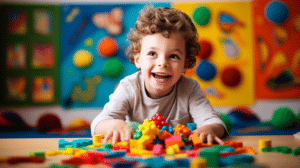Key Takeaways
- Pediatric occupational therapy can help children with ADHD by providing organizational and planning strategies, such as breaking tasks down into small, achievable steps and using visual tools like charts and checklists.
- Sensory processing difficulties are common in children with ADHD, and occupational therapists can recommend sensory-friendly items and provide strategies for managing sensory over- or under-responsiveness.
- Developing self-regulation skills is an essential focus of occupational therapy for children with ADHD, using techniques like The Zones of Regulation® Curriculum to help children identify and regulate their emotions and behavior.
- Occupational therapy can also help improve fine and gross motor skills in children with ADHD, including handwriting, pencil grip, hand strength, eye-hand coordination, core strength, balance, and coordination skills.
Understanding ADHD and Occupational Therapy

In pediatric healthcare, understanding ADHD and the role of occupational therapy is pivotal for developing and implementing effective therapeutic strategies. Attention deficit hyperactivity disorder (ADHD) is a chronic condition that affects millions of children and often continues into adulthood. Symptoms of ADHD include difficulty maintaining focus, hyperactivity, and impulsive behavior. These symptoms can interfere with a child’s daily life, hampering their ability to perform academically and socially.
Occupational therapists play a significant role in treating children with ADHD. These professionals assist children in improving their executive functions, such as organization, time management, and cognitive strategies. This is achieved by implementing occupational therapy interventions tailored to each child’s unique needs.
Occupational therapy focuses on helping children with ADHD develop the skills needed for daily living and independence. Therapists work closely with children to help them improve their fine and gross motor skills and develop self-regulation skills. They also assist in establishing routines and fostering a structured and consistent environment that can benefit children with ADHD.
Moreover, occupational therapists offer strategies to manage sensory processing difficulties often associated with ADHD. By recommending sensory-friendly items and providing strategies for parents and teachers, occupational therapists play a crucial role in mitigating the impact of ADHD symptoms.
Strategies for Organization and Planning
Numerous strategies can be implemented to enhance the organization and planning skills of children with ADHD, which are critical to their overall development and daily functioning. These strategies, commonly embedded in a therapy session, revolve around fostering executive function skills crucial for managing time, tasks, and daily activities.
Firstly, a designated, well-organized study area can significantly improve a child’s ability to focus and complete tasks. Regular organization sessions, supervised by an adult, can help maintain this environment and instill beneficial habits. An assignment system involving a planner or calendar can also be established to manage due dates and break down larger projects into manageable steps. This not only aids time management but also encourages a systematic approach to tasks.
Classroom strategies can also be highly effective. Collaborating with teachers to provide printed handouts of daily assignments, scheduling desk cleanouts, and using a color-coded organizational system can significantly enhance organization skills. These elements should be incorporated into the child’s treatment plan, ensuring a consistent approach both at home and school.
Handwriting difficulties, commonly associated with ADHD, can be addressed by systematically packing and organizing homework materials. This strategy not only supports task completion but also fosters independence.
Finally, a motivating reward system can reinforce the development of organizational habits, effectively serving as a positive reinforcement for improvements.
Sensory Processing Difficulties in ADHD
Addressing the issue of sensory processing difficulties, it is crucial to note that approximately 40% of children diagnosed with attention deficit disorder (ADHD) also grapple with Sensory Processing Disorder (SPD). This condition disrupts the way their brain interprets sensory information. Pediatric occupational therapy is pivotal in helping these children manage their sensory challenges.
sensory information. Pediatric occupational therapy is pivotal in helping these children manage their sensory challenges.
- Pediatric Occupational Therapy: Occupational therapists employ sensory strategies and sensory integration techniques to help children with SPD. The therapy involves activities that stimulate their senses in a structured, repetitive way. Over time, the brain adapts, allowing kids to process and react to sensations more effectively.
- Sensory Strategies: Occupational therapy sessions provide parents and teachers with sensory strategies to help children manage their sensory overload. These strategies include creating a calm and organized environment and incorporating sensory breaks throughout the day.
- Behavioral Therapy: This approach helps children with ADHD improve their executive functioning, which includes mental skills such as working memory, flexible thinking, and self-control. Children learn to manage their behavior, control impulses, and improve social skills.
- Sensory Integration Technique: This technique, an essential aspect of pediatric occupational therapy, helps children with sensory processing disorders make sense of the world around them. They learn to respond appropriately to sensory inputs, thus enhancing their daily functioning.
It’s important to remember that every child’s sensory needs are unique. Tailoring therapy to each child’s needs, celebrating their progress, and cultivating their strengths are integral to supporting children with ADHD and SPD.
Self-Regulation Skill Development
Beyond addressing sensory needs, pediatric occupational therapy also significantly develops self-regulation skills in children with Attention-Deficit/Hyperactivity Disorder (ADHD). Self-regulation skill development is a critical area of focus in ADHD therapy, as children with this disorder often struggle with executive dysfunction, which impacts their ability to control emotions, behaviors, and attention span.
Pediatric occupational therapy provides comprehensive behavioral interventions to enhance a child’s daily functioning. These interventions teach children essential self-regulation skills, such as identifying and managing emotions, implementing strategies to control behaviors, and improving attention span. By learning these skills, children with ADHD can better manage their arousal states, which are often dysregulated due to their disorder.
Understanding and managing arousal states is a vital component of self-regulation. Children with ADHD often experience chronically low or high arousal, making it challenging to achieve optimal arousal, which is crucial for effective self-regulation. Pediatric occupational therapists provide strategies and tools to help these children modulate their arousal states, improving their self-regulation skills.
Additionally, these therapists work closely with parents and educators, providing them with strategies to support the child’s self-regulation skill development at home and in school. This collaborative approach ensures a consistent and supportive environment for the child, further enhancing the effectiveness of the therapy.
Helping Children with ADHD Improve Social Skills
Pediatric occupational therapists also play a crucial role in helping children with ADHD to brush up on their social skills. As specialists in pediatric occupational therapy, they understand that children with ADHD often struggle with social interactions due to impulsivity, hyperactivity, and inattention. Consequently, they design individualized ADHD therapy programs to address these challenges and improve children’s social skills.
- Behavior Therapy: Pediatric occupational therapists use behavior therapy to help children with ADHD understand and manage their behaviors. They may teach behavioral strategies such as self-monitoring, impulse control, and problem-solving to help children interact positively in a classroom environment.
- Communication Skills Training: This involves teaching children how to listen, share, and communicate effectively. Therapists use role-play, social stories, and other interactive activities to help children with ADHD improve their communication skills.
- Social Skills Groups: In these small groups, children learn and practice social skills with peers under the guidance of a therapist. They learn about taking turns, sharing, managing conflicts, and understanding other’s emotions.
- Parent and Teacher Training: Therapists work with parents and teachers to help them understand ADHD and implement effective strategies at home and school. This joint effort helps create a supportive environment for the child to practice and improve their social skills.
Enhancing Fine and Gross Motor Skills
In pediatric occupational therapy, a significant focus is placed on improving fine and gross motor skills in children with ADHD. Therapeutic activities designed by physical therapists aim to enhance coordination, ultimately aiding children in achieving greater functionality in day-to-day tasks.
Fine motor skills, which involve the coordination of small muscles, are pivotal for writing, buttoning clothes, and tying shoelaces. Therapists make use of a variety of techniques and tools to improve these skills. For instance, activities that require detailed hand-eye coordination or enhance finger dexterity can substantially improve a child’s school performance, particularly in tasks such as handwriting.
On the other hand, gross motor skills involve larger muscle groups and are fundamental for walking, running, and maintaining balance. Therapy for enhancing these skills often includes activities that strengthen core muscles and improve overall body coordination.
Due to their motor skills deficiencies, children with ADHD may struggle more than their peers in a classroom setting. However, with the implementation of individualized therapy plans, these challenges can be mitigated. These plans are often broken down into manageable steps, allowing for gradual improvement, which fosters a sense of achievement and boosts self-confidence in the child.
It is important to remember that every child is unique, and what works for one may not necessarily work for another. Therefore, therapy should always be tailored to the child’s needs, considering their strengths and areas of improvement. With patience, understanding, and the right therapeutic interventions, children with ADHD can significantly enhance their motor skills, improving academic and social outcomes.
Techniques to Improve Handwriting Skills
Handwriting skills, a crucial aspect of fine motor development, often pose a challenge for children with ADHD, necessitating specialized techniques for improvement. Occupational therapy can play a significant role in helping children with ADHD enhance their handwriting skills and overall motor coordination. This improvement can significantly impact their school performance and daily activities.
- Handwriting practice activities: Occupational therapists use activities designed to develop handwriting skills. These activities may include tracing shapes, connecting dots, or copying letters and words. These exercises help improve hand-eye coordination and fine motor skills, essential for writing.
- Motor coordination exercises improve hand and finger strength, agility, and motor coordination. Activities may include playing with putty, using scissors, or threading beads.
- Visual-motor integration activities: These activities focus on improving hand-eye coordination. They may involve drawing or copying shapes, puzzles, or building with blocks.
- Adaptive strategies: Occupational therapists may recommend adaptive writing instruments or paper with raised lines to help children with ADHD improve their handwriting skills. These strategies can make learning more comfortable and enjoyable for the child.
Building Independence in Daily Tasks
A significant portion of pediatric occupational therapy for children with ADHD is dedicated to developing independence in everyday tasks, a critical component of their overall growth and functional capability. This aspect of ADHD therapy is not about doing jobs for the child but empowering them to take charge of their day-to-day activities.
Building independence in children with ADHD involves breaking down everyday tasks into manageable steps. This is achieved through a process known as task analysis. For instance, instead of instructing a child to clean their room, each step is explained and demonstrated: picking up toys, putting books on the shelf, making the bed, etc. This way, seemingly overwhelming tasks become achievable activities that the child can independently perform.
Visual aids such as pictorial checklists and task cards are frequently utilized in pediatric occupational therapy to support the child’s understanding and application of the task steps. This fosters a sense of accomplishment and helps boost their self-confidence, promoting independence.
Moreover, behavioral management techniques are an essential part of ADHD therapy. These techniques are integrated into teaching everyday activities, helping children understand the consequences of their actions and encouraging self-regulation skills. This further enhances the child’s ability to manage their daily tasks independently.
Task Analysis for Skill Mastery
Task analysis, a fundamental strategy in pediatric occupational therapy for children with ADHD, is a powerful tool for skill mastery. This process involves breaking down complex everyday tasks into smaller, manageable steps tailored to the child’s skill level. Therapists utilize this technique to provide structured learning opportunities, turning seemingly overwhelming tasks into achievable goals.
- Identification: Therapists begin by identifying the task and the child’s current skill level. They observe the child performing the task, noting areas of difficulty.
- Breakdown: The task is then broken down into smaller steps. This step-by-step breakdown facilitates understanding and allows the child to focus on one aspect at a time.
- Teaching: Techniques are employed to teach each step independently. This could involve verbal instructions, visual aids, or hands-on guidance. The aim is to ensure the child understands and can perform each action before moving on to the next.
- Reinforcement: Regular practice and positive reinforcement are crucial for skill mastery. Therapists and classroom teachers work together to provide consistent learning opportunities and support.
Task analysis promotes skill mastery and enhances self-esteem and independence in children with ADHD. It is an effective intervention that provides a structured approach to tackling disorders that affect the execution of everyday tasks. This approach, combined with empathy, patience, and a deep understanding of the child’s needs, can significantly improve their ability to navigate daily life.
Therapeutic Programs for ADHD Children
Integrating task analysis into various therapeutic programs can provide children with ADHD the necessary support to enhance their skills and manage their symptoms more effectively. Pediatric occupational therapy is indispensable in the holistic management of this mental health condition, focusing on facilitating participation in meaningful occupations for these children.
In the learning context, therapeutic programs for ADHD children are designed to improve their executive functioning skills, including attention, planning, memory, and organization. The task analysis approach deconstructs activities into manageable steps, enhancing their ability to understand and complete assignments. Furthermore, occupational therapists help devise personalized sensory diets, incorporating activities that calm the child’s body, thus improving focus and attention.
Self-regulation is a critical element of ADHD therapy. Occupational therapists employ deep breathing exercises to curb hyperactivity and promote attention. These strategies also assist children with attention deficits manage their emotions and behavior, promoting self-awareness and self-control.
Environmental adaptations are also an integral part of these therapeutic programs. Occupational therapists ensure optimal classroom seating arrangements and a decluttered workspace to reduce distractions and improve focus. The ultimate goal is to create a structured and organized environment that bolsters the child’s ability to stay focused and engaged, enriching their academic and social experiences. Through diligent and empathetic care, these therapeutic programs pave the way for children with ADHD to lead fulfilling lives.
Frequently Asked Questions
What Other Mental Health Disorders Can Be Treated With Pediatric Occupational Therapy?
Pediatric occupational therapy can provide beneficial treatment for numerous mental health disorders, including Autism Spectrum Disorder, anxiety disorders, and learning disabilities, by improving self-regulation, sensory processing, and motor skills.
Can Children With ADHD Participate in Regular School Activities and Sports?
Yes, children with ADHD can participate in regular school activities and sports. They can manage their symptoms, improve their focus, and effectively engage in academic and physical activities with appropriate strategies and support.
Are There Any Specific Diets or Nutritional Guidelines That Can Help Manage ADHD Symptoms in Children?
Yes, certain dietary modifications can help manage ADHD symptoms in children. A balanced diet rich in protein, complex carbohydrates, and omega-3 fatty acids is recommended. Limiting sugar and artificial additives may also be beneficial.
How Can Parents and Caregivers Support the Therapy Process at Home?
Parents and caregivers can support therapy at home by creating structured routines, utilizing visual aids for organization, promoting self-regulation skills, and encouraging independence in everyday tasks while remaining patient, supportive, and empathetic.
Are Any Side Effects or Risks Associated With Pediatric Occupational Therapy for Children With ADHD?
Pediatric occupational therapy is generally a safe intervention. Side effects or risks are minimal, but they may include frustration or emotional distress during challenging tasks. Constant professional monitoring effectively mitigates these potential issues.
How does an Occupational Therapist help with ADHD?
An Occupational Therapist and ADHD treatment work together to support children in developing focus, organization, and self-regulation skills. Through tailored activities, therapists help children manage their ADHD symptoms and succeed in daily tasks.
Conclusion
In conclusion, Pediatric Occupational Therapy is pivotal in managing ADHD, providing a comprehensive and holistic approach. It enables children to conquer daily challenges, enhancing self-regulation, motor skills, and organization. A striking statistic is that approximately 6.1 million children in the U.S. have been diagnosed with ADHD. This highlights the urgent need for effective therapeutic interventions like Pediatric Occupational Therapy that address the symptoms and empower these children to lead fulfilling, independent lives.


Recent Comments